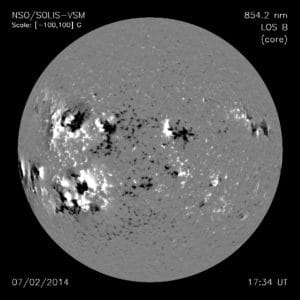
Space weather, entailing the useful forecasting of major events such as solar flares and coronal mass ejections (CMEs), isn't merely of academic or abstract interest. This is because we know major adverse events can knock out our satellites, as well as disrupt telecommunications systems, not to mention affect the navigational instruments on aircraft.
For years, ever since the mammoth project I described some time ago, based on this released monograph:
http://brane-space.blogspot.com/2015/04/one-of-most-massive-scientific-projects.html
we've also known that forecasting serious events requires a solid understanding of the solar wind, a 1, 610,000 kph stream of charged particles constantly emitted by the Sun in all directions. However, solar wind dynamics are maddeningly complex as the original contributors to the Solar-Terrestrial Predictions Workshop held in Meudon, France learned.
Now, new research by Feng et al (Journal of Geophysical Research, Space Physics, 2015) discloses a different approach and also improves on previous efforts to model the solar wind. This model is driven by real world data, from which it predicts the behavior of the solar wind from the moment it leaves the Sun until its arrival at Earth.
Feng's team based this new model on an older magnetohydrodynamic simulation that predicts the behavior of an electrically conducting fluid (the solar wind in this case) in the presence of a magnetic field. This older model relies on daily maps of the Sun's light emitting layer known as the photosphere. Such an image, from a vector magnetograph, is shown below:

In the image shown above, for example, the (+) magnetic polarities are visible as bright regions, contrasting with the (-) polarities in dark. To improve the older simulation, Feng et al changed the way the daily magnetic field data are processed and used by the model. They also added a limit on the mass flux of the photosphere, that is, the energy it emits over a given surface area.
The team then tested the new model's predictions against solar wind predictions from July 1 to August 11, 2008. The model was found to accurately predict specific features in the corona including dark coronal holes and their corresponding streamer 'belts' (the bright rays seen emanating out during a total solar eclipse). The model also accurately predicted interplanetary solar wind behavior.
Unfortunately, the model was less accurate at predicting the total magnetic field strength during the observation period. Hence, improvements are needed but the Fong et al model can definitely help to make better predictions about space weather, including extreme events like coronal mass ejections.
At the very least the model enhances forecasting from where it had been and that is a win for solar physics. The bottom line is that plasma behavior under the influence of powerful magnetic fields is often chaotic, as opposed to deterministic. This is what leads to more 'stochastic' forms of prediction which by their very nature harbor significant uncertainty.
As more data are accessed, from diverse instruments, and refinements made via computer processing and imaging, we may finally be on the way to more confident space weather forecasts.
See also the latest space weather forecasts, etc. at:
www.spaceweather.com
No comments:
Post a Comment